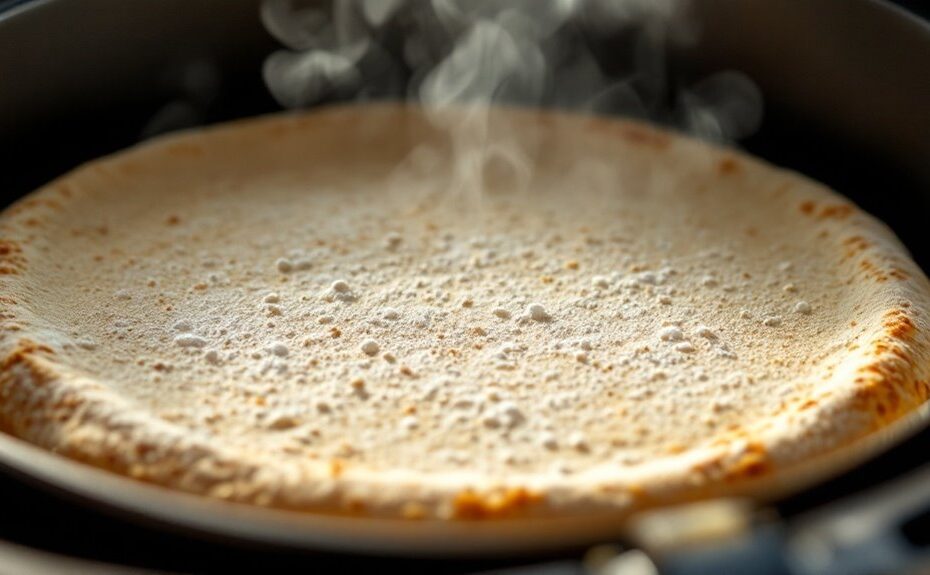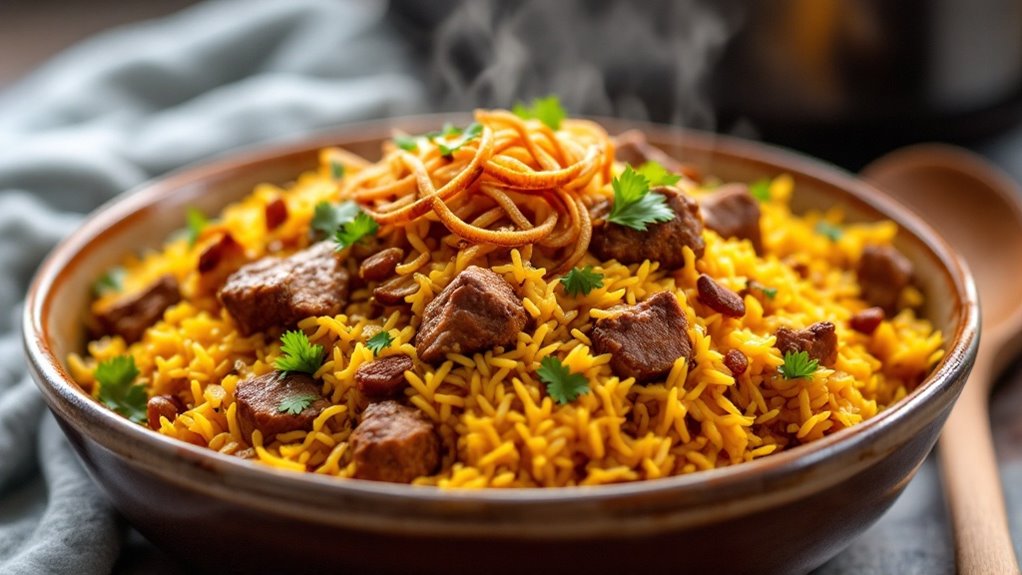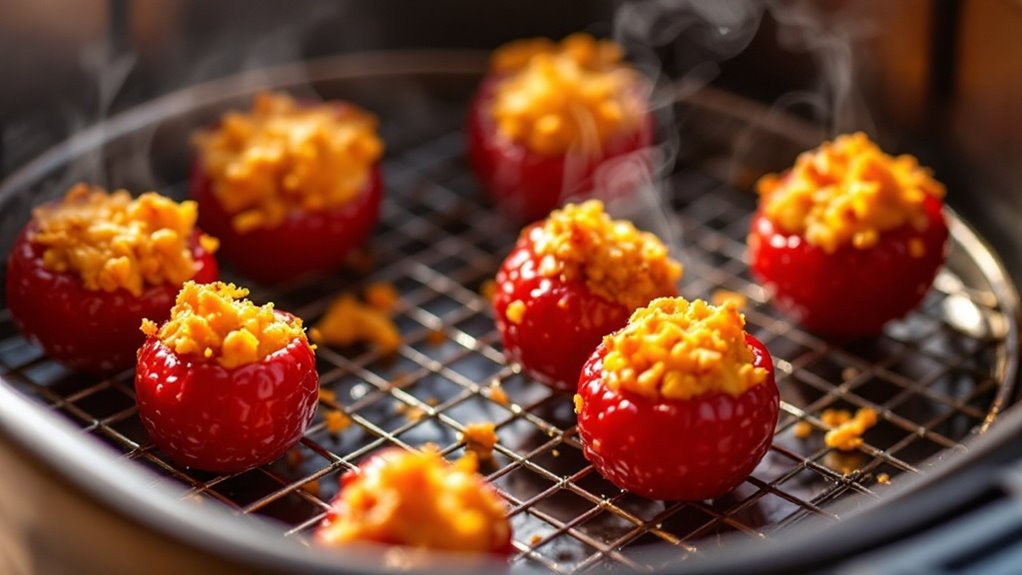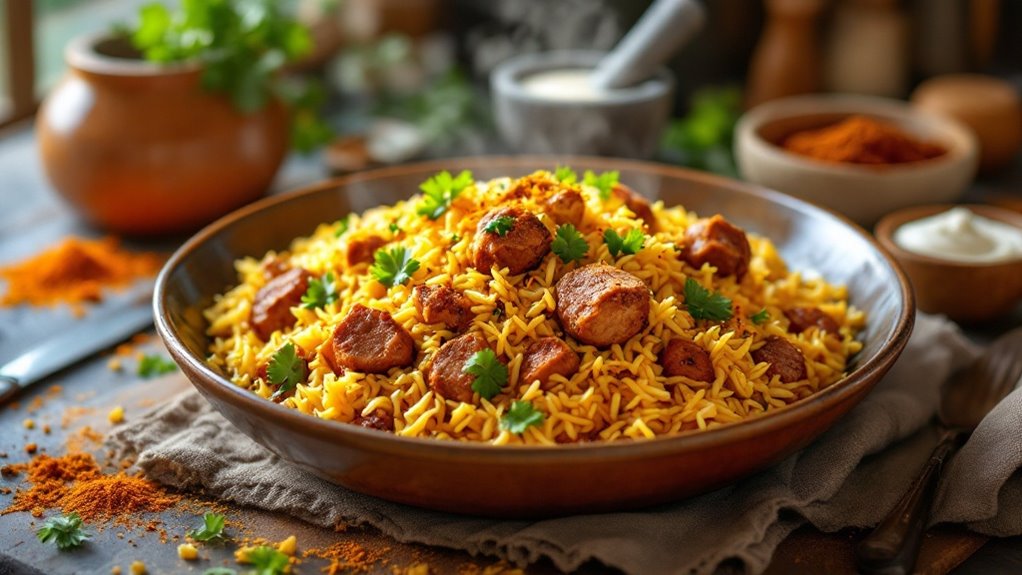You might think a pizza stone is only for traditional ovens, but it can also transform your air fryer into a mini pizza oven. However, using one requires more than just tossing it in—you'll need to evaluate the stone's material, size, and how it interacts with the air fryer's rapid heating. Preheating is essential, and you must avoid sudden temperature changes to prevent cracking. But what happens when you get it right? The results could be a game-changer for your homemade pizza. The real question is, are you ready to experiment and tap into its full potential?
Key Takeaways
- Pizza stones can be used in air fryers if they fit properly and are made of heat-resistant materials like cordierite or ceramic.
- Ensure the pizza stone fits the air fryer basket without blocking airflow to avoid uneven cooking or damage.
- Preheat the stone in the air fryer at 400°F for 10-15 minutes to prevent cracking from thermal shock.
- Avoid sudden temperature changes and handle the stone with oven mitts to prevent burns or damage.
- Use parchment paper to prevent sticking and monitor cooking time, as air fryers heat faster than traditional ovens.
Understanding the Basics of Pizza Stones
A pizza stone is a flat, heat-resistant surface typically made from ceramic, cordierite, or clay, designed to mimic the effects of a brick oven. The pizza stone materials you choose impact heat retention and durability; cordierite resists thermal shock, while ceramic offers even heat distribution. Clay stones, though traditional, may crack under extreme temperature changes. The pizza stone benefits include achieving a crisp crust by absorbing moisture from the dough and evenly distributing heat for consistent cooking. You'll notice improved texture and flavor compared to baking directly on metal trays. Properly preheating the stone guarantees peak performance. Avoid sudden temperature changes to prevent cracking. Understanding these basics guarantees you maximize your pizza stone's potential, whether in an oven or exploring alternative cooking methods.
How Air Fryers Work for Cooking
Air fryers cook food by circulating hot air rapidly around it, creating a crispy exterior similar to frying but with substantially less oil. The air fryer mechanics rely on a heating element and a powerful fan, which work together to distribute heat evenly. This cooking technology guarantees consistent results, whether you're reheating leftovers or preparing fresh dishes. You'll notice that air fryers preheat quickly, reducing cooking time compared to traditional ovens. The compact design maximizes efficiency, making them ideal for smaller kitchens. By adjusting temperature and time settings, you can achieve precise control over your cooking. Understanding these mechanics helps you optimize performance, securing your food cooks evenly and retains moisture while developing a satisfying crunch. This method is both healthier and more energy-efficient than deep frying.
Compatibility of Pizza Stones and Air Fryers
While pizza stones are traditionally used in conventional ovens to create a crispy crust, their compatibility with air fryers depends on the specific model and design. Air fryer capacity is a critical factor; smaller models may not accommodate standard-sized pizza stones, limiting their use. Additionally, pizza stone materials, such as ceramic or cordierite, must withstand rapid air circulation and high temperatures typical of air fryers. Make sure your stone fits securely within the fryer basket or tray without obstructing airflow. Some air fryers include accessories like baking trays, which may better suit your needs. Always check your air fryer's manual for size restrictions and temperature limits to avoid damaging the appliance or the stone. Proper compatibility guarantees even cooking and prevents safety hazards.
Potential Risks of Using a Pizza Stone in an Air Fryer
Using a pizza stone in an air fryer introduces several risks that could compromise both the appliance and your safety. Thermal shock is a primary concern, as rapid temperature changes can cause the stone to crack or shatter. Air fryers heat up quickly, and the confined space may not allow for even heat distribution, increasing this risk. Additionally, material safety is critical; not all pizza stones are designed to withstand the high, direct heat of an air fryer. Some materials may release harmful chemicals or degrade under these conditions. Always verify the stone's heat tolerance and confirm it's compatible with your air fryer's specifications. Ignoring these factors could damage your appliance or create unsafe cooking conditions.
Choosing the Right Pizza Stone for Your Air Fryer
When selecting a pizza stone for your air fryer, it's crucial to prioritize materials and dimensions that align with your appliance's capabilities. Opt for a stone material like cordierite or ceramic, as they retain heat effectively and withstand high temperatures. Avoid stones with coatings or glazes that may crack under rapid heating. For size selection, measure your air fryer basket to guarantee the stone fits comfortably without obstructing airflow. A smaller stone, typically 8-10 inches in diameter, works best for most models. Make sure the stone's thickness is moderate—around 0.5 inches—to balance heat retention and weight. Always verify the stone's compatibility with your air fryer's maximum temperature rating to prevent damage. Choosing the right stone guarantees peak performance and longevity for both your appliance and the accessory.
Preheating a Pizza Stone in an Air Fryer
To guarantee your pizza stone performs at its best in an air fryer, preheating it is essential. Start by placing the stone in the air fryer basket or tray, making sure it fits without obstructing airflow. Set the temperature to 400°F (200°C) and allow the stone to preheat for 10-15 minutes. This guarantees even heat distribution and prevents thermal shock. Use precise preheating techniques to maintain temperature control, as sudden changes can crack the stone. Avoid opening the air fryer frequently during preheating, as this disrupts the internal temperature. Once preheated, the stone will retain heat efficiently, creating a crisp crust for your pizza. Always monitor the process to make sure the stone doesn't overheat or exceed the air fryer's maximum temperature limit.
Tips for Safe Usage of a Pizza Stone in an Air Fryer
While a pizza stone can enhance your air fryer cooking, it's crucial to follow safety guidelines to prevent damage or accidents. Always make sure your pizza stone is rated for safe temperatures up to at least 500°F (260°C) to withstand the air fryer's heat. Proper placement is critical—center the stone on the air fryer basket or tray, leaving enough space for airflow around the edges. Avoid sudden temperature changes, such as placing a cold stone directly into a hot air fryer, as this can cause cracking. Use oven mitts when handling the stone, as it retains heat for extended periods. Never submerge a hot stone in water; let it cool completely before cleaning. Following these precautions guarantees safe and effective use.
Achieving the Perfect Crispy Crust
Using a pizza stone in an air fryer can elevate your crust to a crispy, restaurant-quality finish. To achieve this, focus on crust thickness and dough hydration. A thinner crust, around 1/4-inch thick, crisps more effectively than a thicker one. For the best outcomes, aim for a dough hydration level between 60-65%, as this balance guarantees a crisp exterior while maintaining a tender interior. Preheat the pizza stone in the air fryer for at least 10 minutes at 400°F to mimic a traditional oven's heat retention. Avoid overloading the pizza with toppings, as excess moisture can hinder crispiness. Monitor cooking time closely, typically 8-12 minutes, to prevent burning. Adjust air fryer settings as needed to achieve even browning and a satisfying crunch.
Alternative Methods for Cooking Pizza in an Air Fryer
If you don't have a pizza stone, you can still achieve excellent results in your air fryer by employing alternative methods. Use parchment paper or a silicone baking mat to prevent sticking and guarantee even cooking. Preheating the air fryer is essential for a crispy crust, so set it to 375°F for 3-5 minutes before adding your pizza. For pizza alternatives, try using naan, pita, or tortillas as quick bases. These air fryer hacks allow you to customize toppings while maintaining a crisp texture. Avoid overloading with toppings, as excess moisture can lead to a soggy crust. Cook in small batches, checking halfway through to rotate for even browning. These methods deliver restaurant-quality results without a pizza stone.
Cleaning and Maintaining Your Pizza Stone After Use
After cooking with your pizza stone, proper cleaning and maintenance are key to preserving its quality and extending its lifespan. Avoid using soap or harsh detergents, as they can absorb into the porous surface and affect flavor. Instead, scrape off food debris with a plastic scraper or stiff brush, then wipe the stone with a damp cloth. For stubborn residue, use a paste of baking soda and water, but never submerge the stone in water, as it can crack. Dry it thoroughly before storing. To maintain its non-stick properties, follow stone seasoning tips: lightly coat the surface with olive oil and bake it at 400°F for 30 minutes. Use cleaning tools recommendations like silicone brushes or non-abrasive pads to avoid damaging the stone's surface.
Disclosure: As an Amazon Associate, I earn from qualifying purchases.



